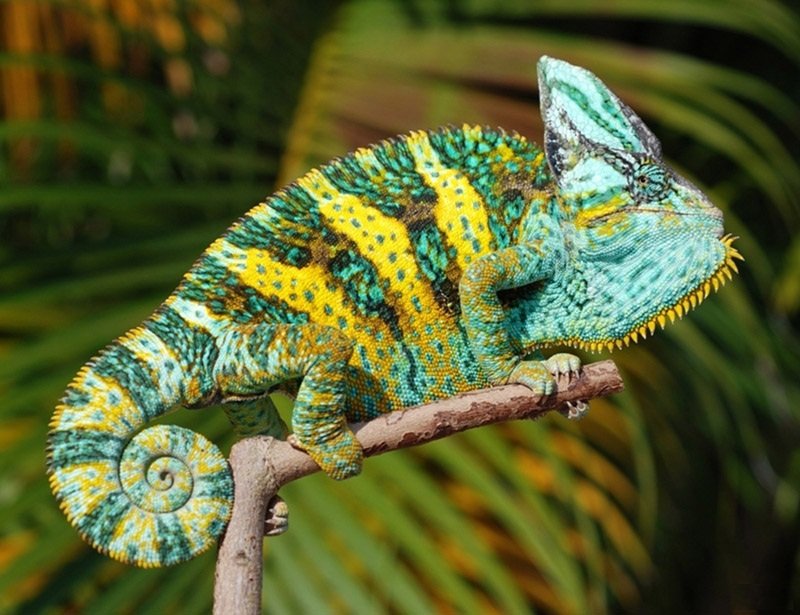
Think of it like meeting someone new at a party. Their behavior can vary based on the situation, mood, and even their environment. The Veiled Chameleon is no different. How they react can depend on several factors, including temperament, handling, and overall care. So, if you’re considering bringing one of these enchanting reptiles into your home, let’s explore the real deal behind their temperament.
Understanding the Veiled Chameleon’s Nature
Veiled Chameleons, also known as *Chamaeleo calyptratus*, are native to Yemen and Saudi Arabia. Their striking appearances—bold colors and a unique crest on their heads—make them a favorite among reptile enthusiasts. But looks aside, it’s their behavior that truly fascinates many potential owners.
You might be wondering how their natural habitat influences their personality. In the wild, they’re solitary creatures. This means that in their natural setting, they’re not used to interacting with others of their kind, which can make them seem a bit standoffish. Just like a person who prefers quiet nights at home, these chameleons enjoy their alone time. If they feel threatened or stressed, they might become defensive, which can come off as aggression.
A Key Point to remember: their shyness doesn’t mean they are mean. Instead, they’re just trying to communicate their comfort level. A chameleon that feels secure will display more vibrant colors and a relaxed posture, showing you their true personality.
The Spectrum of Behavior: Shy vs. Aggressive
When evaluating whether a Veiled Chameleon is aggressive or friendly, it’s important to understand that their behavior can range widely. Initially, they might appear shy, hiding or turning darker, but this doesn’t automatically mean they’re aggressive.
Signs of a Friendly Chameleon:
– Bright Colors: If your chameleon is displaying vibrant hues, it’s usually a sign of happiness and comfort.
– Curious Behavior: If it actively explores its environment and engages with you, that’s a good indication of a friendly demeanor.
Signs of Aggression:
– Darkening Colors: A darker chameleon is often feeling threatened or stressed.
– Hissing or Puffing Up: This is a clear warning sign, much like when a dog growls; it’s their way of saying, “Back off!”
Recognizing these signs helps you understand your chameleon’s mood and adjust accordingly. The more you observe, the better you’ll become at interpreting their body language.
Handling and Socialization Tips
If you’re set on making a Veiled Chameleon part of your family, understanding how to handle them is key. Like anyone else, chameleons have their quirks and preferences.
Best Practices for Handling:
1. Be Calm: Always approach your chameleon slowly. Sudden movements can startle them, leading to stress.
2. Use a Gentle Touch: When picking them up, support their body with both hands, allowing them to feel secure.
3. Limit Handling Time: Especially in the beginning, keep handling sessions short. This allows your chameleon to gradually get used to human interaction.
Remember, socializing a chameleon is a slow process, like building trust with a new friend. Rushing them can lead to negative associations with handling, making them more defensive.
Creating a Comfortable Environment
Your chameleon’s environment plays a huge role in their behavior. A happy, healthy chameleon is more likely to show friendliness than one living in a stressful habitat.
Here’s What to Focus On:
– Proper Temperature: Veiled Chameleons thrive in warm environments. Make sure their habitat has a proper heat gradient, so they can choose their comfort level.
– Humidity Levels: Keeping humidity between 30-60% is crucial. Too dry or too humid can stress your chameleon.
– Hiding Spots: Adding branches, foliage, and hiding places allows them to retreat when they want some alone time, which can ease their anxiety.
A well-maintained habitat not only enhances their well-being but also sets the stage for a friendlier disposition.
Common Misconceptions About Veiled Chameleons
There are plenty of myths floating around about chameleons, especially when it comes to their temperament.
The Truths Behind Some Common Misconceptions:
– “Chameleons are great pets for beginners.” While they can be lovely companions, their specific care requirements can be challenging for first-time reptile owners.
– “They change colors based solely on mood.” While mood can affect their coloring, chameleons also change colors for temperature regulation and camouflage.
Understanding the reality behind these myths helps set the right expectations for anyone thinking about adopting a Veiled Chameleon.
What to Expect as a Chameleon Owner
If you decide to welcome a Veiled Chameleon into your home, you’ll be in for a unique experience. But it’s not all rainbows and sunshine; there’s a learning curve involved.
Here’s What You Might Encounter:
– Patience is Key: Expect to invest time in bonding. These creatures don’t warm up instantly.
– Ongoing Learning: As you get to know your chameleon, you’ll uncover more about its preferences and behaviors, making the experience rewarding.
– Regular Health Checks: Monitoring their health is important. Be on the lookout for any changes in behavior or physical appearance, as these can indicate health issues.
Becoming a chameleon owner means embracing both the challenges and joys of caring for a unique pet. With patience and care, you can build a bond that feels as vibrant as your chameleon’s colors.
In the end, whether the Veiled Chameleon is perceived as aggressive or friendly boils down to a mix of factors—its individual personality, your handling techniques, and the environment you provide. These fascinating creatures can indeed display shy or defensive behaviors, but with the right care and understanding, they can also become intriguing and colorful companions.
As you embark on the journey of chameleon ownership, remember to take your time and respect their unique personalities. After all, just like people, they might take a little while to warm up! So, gear up for an adventure filled with patience, observation, and a lot of color.

